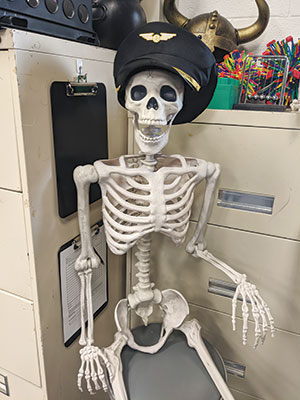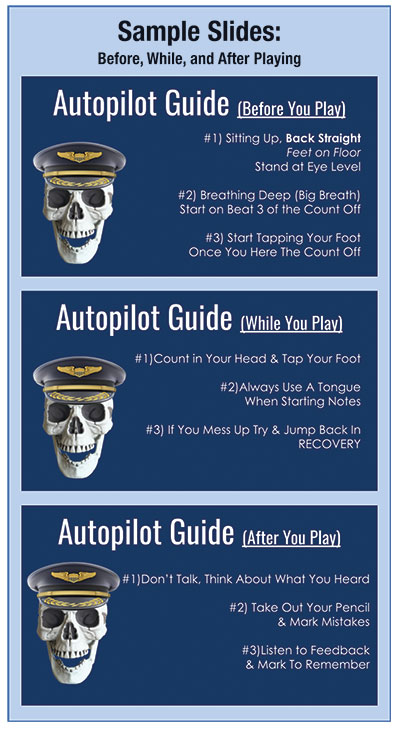The past three years have changed us all – teachers, students and parents – in one way or another. While challenges and obstacles can help us grow in ways that we might not expect, they can also feel heavy to carry, like a weight holding us back or pulling us down. I would like to make a confession; I have been frustrated this year, more so than I would have liked. If that has been you as well, you are not alone and you are not a bad teacher. As Duke women’s basketball coach Kara Lawson would say, we are all just having to learn how to “handle [our] hard better.” Born from the challenges and obstacles I faced was Norbertt, my copilot in class.
The Problem
My beginning woodwind class this year has been one of the hardest groups of beginners I have taught on many levels. Much of a teacher’s job is reminding students how to do things: teaching and reteaching. This group of students however, perceived it almost like a parent nagging them to do something. I would say, “remember to” or “let’s focus on,” and with the next repetition there would be no change. We were at a stalemate. It was not because of their interest level. They were very interested, but they just did not process instruction in the same way previous students had. New times call for new ways, and frankly I needed backup.
Finding a Solution
To solve my problem, I went to Target and found a skeleton. Crazy, I know, but hear me out. This year our school has focused on co-teaching, which is great for teachers and students who need the additional support or an extra set of hands. However, there was no one who could assist me. I needed a co-pilot to lighten the load. The idea was born in the month leading up to Halloween when there were skeletons everywhere. I had the thought that since I was never going to get a co-pilot, I would make my own. I purchased the skeleton and a pilot cap to match and brought him into the classroom.
At first there were pauses and blank stares, but that did not last long. The first question was, “Can we name it?” Once I heard that I knew that I was on to something and agreed. After some creative discussions, they settled on Norbertt with two t’s because it is more distinguished that way. Now that he had an identity, a name that could be referenced, he took on a new life. It was a cute adoption of sorts. I gave him an introduction and stated he was here to help us and show us the way. Norbertt heard, Norbertt thinks that you should, or Norbertt wants you to became a different voice in the classroom. I was no longer the lone wolf.
Now I should mention that a skeleton is not for everyone’s teaching style or personality. Everything that you present to your students, you must embrace with enthusiasm and joy for them to buy into it. This is just an idea. Teachers take an idea, mold it, and meld it into something that will fit us, our students, and the situation. There are many ways to reach people, but never try to fit a round peg in a square hole. You will create a much more authentic experience for your students by being true to who you are and who they are.
Additional Techniques
Why was this even needed? A good portion of students of today use computers for assignments. They are used to reading numbered instructions, in the simplest and most straightforward language, instead of processing verbal instructions and filling in the gaps with more abstract thoughts. This is especially true after several years of remote lessons and interrupted school years.
To help counter this and create a new way of training, I developed slides that accompanied Norbertt, complete with steps that I wanted my students to focus on. The slides are divided up into three categories: before you play, while you play, and after you play. On each slide there are about three things to focus on for that part of the process. The content on the slide changes, develops and evolves over time depending on what students need or do not need to focus on anymore.
Students can only direct their attention to so much at a time, so I try to create lists that are no longer than three items. However, when the group is ready, I will add only one or two more points if more differentiation is required. On some days, students can only focus on one or two ideas, and that is okay. You have to teach them where they are. If they are not ready, they are not ready. The process is all about the journey. If you and the students are not enjoying the process, then the journey will not happen.
Assessments
During assessment preparation, Norbertt’s role changes slightly and takes a new direction. The focus shifts from emphasizing the process of what we are doing to Norbertt being an adjudicator. This serves two purposes. First, I am focusing on the terminology used on the sheets and shaping their conceptual understanding while creating a non-threatening experience with an adjudicator. I am also shifting the students’ focus to evaluation of what they are hearing both individually and as a group. While I have done both of these things from the beginning, students need to be reminded regularly because they all learn differently and at different times. You never know when the lightbulb is going to click.

Keep It Fun
Do not forget it is supposed to be fun. Having enjoyment with Norbertt is just as important as what Norbertt is saying. It creates a bond between presentation and material that makes it more memorable. The goal is for students to remember and demonstrate the content. After using him in class for a while, I like to create enjoyable activities and different interactions with him for my students. Costumes and accessories are key. It might be seasonal clothing or the addition of a fun hat when he is off duty.
Another option is to let students bring in items for him as a reward. It has been very motivating. Items brought in have included a wig for a new hairstyle, a pet (in the form of a stuffed animal), and even a friend (with additional skeletons making an appearance). The possibilities are endless.
Another fun activity students like is to “sit beside Norbertt for a day.” You can use it to reward students for behavioral or instructional achievements. Since Norbertt lives in the front of the room, I let students decide whether they want to sit beside him or if they want him to sit beside them. It has become quite interesting to see the students embrace him in their sections and make him part of the group. It is an additional way to keep things light and create smiles every day. Making at least one moment when students laugh every day in the classroom goes such a long way towards relationship building and retention in my groups.
This idea has really helped me engage my students’ interest and get them out of their shells. It will also help shape their future experiences. Presenting topics by focusing on the process, teaching students how to think for themselves, and engaging with the material in new ways is critical for success. I hope that some part of this idea will help with your classroom so that when you come in for a landing, everyone can say it was an enjoyable ride.







